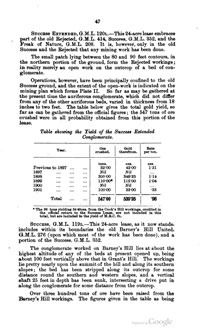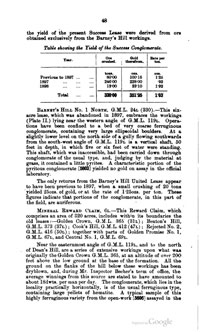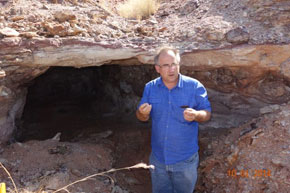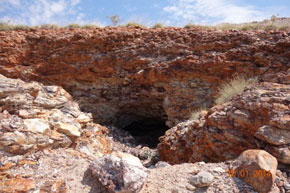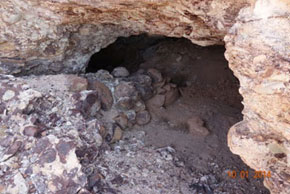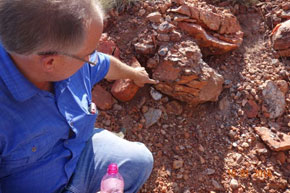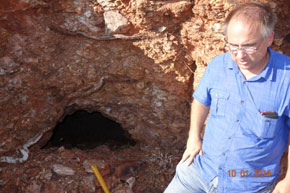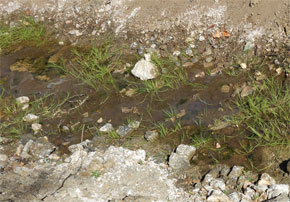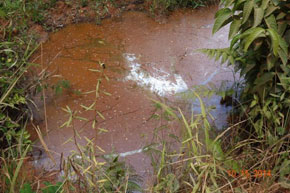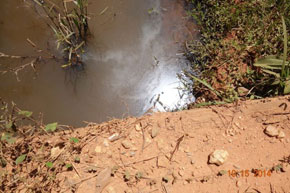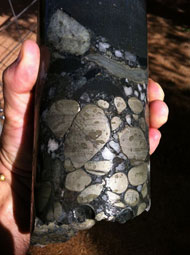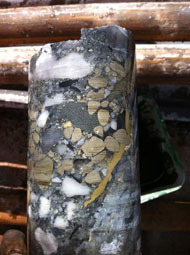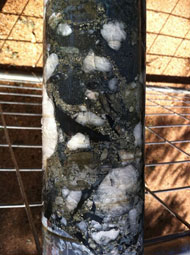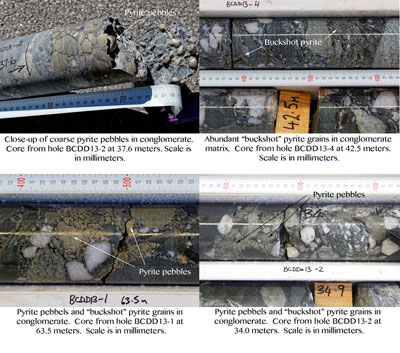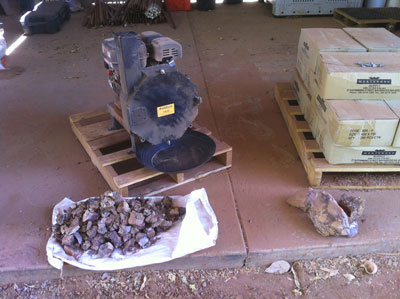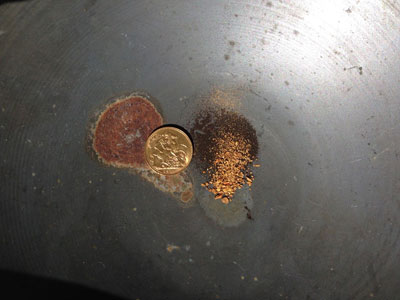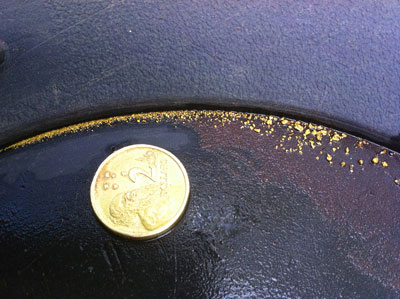|
||||||||||||||||||||||||
Novo’s Latest NewsBob Moriarty I have written at some considerable length about Novo’s Witwatersrand lookalike gold project in Western Australia. Rather than rehash what I have repeated again and again, I suggest interested readers go back and read what I have written before. I went to visit the Nullagine gold project of Novo at the end of September. The company is finishing up a series of 353 RC holes. In addition they have completed over 400 surface samples. When Novo ran the last set of drill holes a year ago, management was disappointed with the results because they didn’t correlate with the results they had been getting from prior drilling and had expected. Novo and Newmont put their heads together to figure out what the problem was. Results from 115 years ago in the Nullagine gold district showed between 10 g/t up to 60 g/t gold. Novo was doing something wrong to get the results they got. (Click on images to enlarge) Novo is drilling through conglomerate. The conglomerate consists of both cobbles that contain no gold and the matrix that is gold rich. If Novo drills through a lot of cobbles, they get low-grade results. If they drill through a lot of matrix they get much higher grades. At the end of the brainstorming between Novo and Newmont, they concluded the low grades were a result of the “nugget effect” and for more accurate results, hopefully higher, they needed to be assaying much larger samples. The drill samples will be 20 kilos; the surface or costean samples will total 40 kilos. Bigger samples require far more work on the part of the assay lab. I wanted to do a piece as soon as I saw the progress at Nullagine but all I could really say was it was going to take another two months to see any results. Results from the assays now look as if they will start coming out in the next two to three weeks. Expect results from the two deep drilling holes around the beginning of January. The surface samples are far more important than they would be at most deposits. They represent exactly what will be mined and are large enough to represent exactly the grade Novo will be mining. They do not measure indications of gold; they measure what will be produced. On this trip to a much greater extent than I had seen on my first two trips to the Pilbara, I saw the impact of the bacterial remobilization of gold as reflected in the amount of buckshot pyrite. Quinton’s theory basically holds that due to the chemical composition of water 2.8 billion years ago when the Witwatersrand and the Pilbara basin were formed, all surface gold would have been in solution. As the chemistry of the water changed around 2.3 billion years ago due to the GOE (Great Oxygenation Event) gold began to precipitate out of solution through both chemical and biological action. The GOE affected the chemistry of the earth and of the gold in solution but bacterial action was just as important. Certain bacteria or microorganisms attract sulfides and gold associated with those sulfides and cause the gold to precipitate out of solution. This happened 2.3 billion years ago as the Pilbara conglomerates were creating the basin and it happens today. The photos above were taken on my recent trips to Columbus Gold and California Gold Mining. Hard working bacteria create the oily scum on top of the water as they reduce the sulfur in solution and concentrate the gold as free gold. With sulfide gold you never see the gold, it’s too small, but often with oxide gold, you do. This paper talks about the action of the bacteria. It’s written in Sanskrit but is a lot more readable than most reports.
Few geologists actually understand the mobility of gold either through chemical action or through bacterial action. If you go deep in the heart of the Amazon you will find giant gold deposits associated with deeply weathered laterite over less weathered saprolites. The Amazon jungle consists of three types of ground and vegetation, that which is always under water, that which is under water during the rainy season and that which is never under water. The regular seasonal rains change the chemistry of the soil and gold will precipitate from the sulfides below the saprolites. There will be very coarse visible gold at surface. As the miners went deeper, the visible gold got smaller and smaller. As they go below the laterite layer into the saprolite layer, the gold is only found with sulphides and is so small that it is invisible. The same is true in Northern California in peach orchards. When farmers pull up dead trees, they often find small gold nuggets at the end of the roots where the cyanide from the tree has attracted gold in the soil to form a nugget. [Editor’s note: Peach farmers might want to put very high fences around their orchards now that Bob’s let the cat out of the bag.] At Nullagine both the existing buckshot pyrite in the sulfide ore and the holes where the buckshot pyrite has weathered out tell Novo where the best gold will be. In the drill core above, we can see the buckshot pyrite in place. Where surface water and oxygen have weathered the rock, we see where the pyrite used to be but the gold still is. To test his theory and to see the size of the gold near surface, Quinton shipped a small impact crusher to Nullagine. I got to be there when he first tested it. The “experts” played around with it for 30 minutes before giving up on their ability to start the “bloody contraption.” I saved the day by finding the fuel and choke controls and moving them into the operating position. Then it started on the first pull. When I was there we broke up a bunch of the near surface conglomerate and fed it into the machine. I’d guess we put in about 25 pounds or around 12 kilos, similar to what Quinton would test later. The machine worked as advertised and we panned the output of the crusher. Granted, we did high grade the material by selecting only the badly pockmarked rock with holes where the buckshot pyrite had been. I showed right at 1.1 grams in the gold I brought home. If you figure 80 times that to make a tonne, you would have three-ounce material. Even the old-timers would have some dilution so our grade would be similar to what they got 115 years ago. Quinton tested 12 kilos of material and the photo below is what he got. A side benefit of the test showed the gold to be fairly large for placer so gravity will work. The latest press release showed similar results in the lab ranging from 71% to 92.7% recovery. That makes mining this material very cheap, perhaps one of the cheapest mines in the world. The Nullagine gold project consists of a number of layers of conglomerate. Quinton wants to select the highest-grade layers, near surface for mining. He wants to scrape off the waste rock and only mine the high grade. By being very selective of what he mines, Novo can produce a lot of gold without milling a lot of material. 115 years ago, the miners were doing one ounce plus material. Quinton doesn’t intend to be quite that selective but it will be high-grade material that can be processed very cheaply. I view my trip as being very productive. I got to see exactly where the gold was and how it got there. The conditions in the Pilbara right now are abysmal. Quinton was whining about 45-degree temperatures and eventually I realized he was talking centigrade, not Fahrenheit. 45 decrees C is about 113 F in the shade and there isn’t any shade. That’s bloody hot. The shares have gotten hammered due to Pinetree dumping everything in their inventory and the market in general but they are back to being pretty darned cheap. Quinton’s intentions are to get into production as soon as possible. He intends to have the feasibility study completed by mid-2015. After that, Millennium Minerals has to start kicking in 30%. The BLEG work hasn’t all come in yet but what Newmont has released shows the current area as the most gold productive. I think the deep holes could be a game changer. Quinton believes the periphery of the basin is where the most biological remobilization would have taken place but I suspect there will have been a lot of chemical remobilization taking place in the deeper sections. Only drilling will tell the whole story. Those results are 6-7 weeks out. I own shares; I have participated in every PP. I am biased as I can be. Please take some responsibility for your own actions.
Novo Resources ### Bob Moriarty |
||||||||||||||||||||||||

